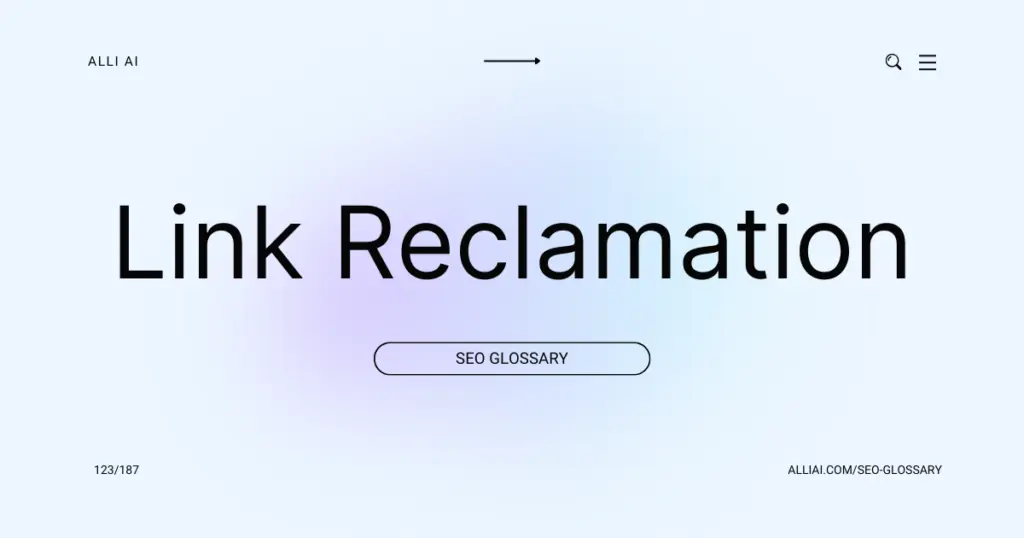What Does Link Reclamation Mean?
Link reclamation is the process of finding and fixing broken links pointing to your website or reclaiming lost links by reaching out to websites that mentioned your brand or content without linking to you. The goal is to restore these links to improve your site’s SEO and enhance its authority and traffic.
Where Does Link Reclamation Fit Into The Broader SEO Landscape?
Link reclamation involves identifying and fixing broken or lost links pointing to your website. This strategy fits into the broader SEO landscape as a critical part of maintaining and enhancing a website’s link profile and overall health. Accrued backlinks can degrade over time due to changes in linking pages or removals of links, which negatively impacts SEO by reducing a site’s authority and ability to rank higher in search engines. By reclaiming these links, either by fixing broken ones or reaching out to site owners to restore lost ones, SEO professionals help preserve the page rank and enhance the credibility of a website, contributing positively to its SEO strategy. This process also aids in ensuring content relevancy and user experience, both vital factors for SEO success.
Real Life Analogies or Metaphors to Explain Link Reclamation
Link Reclamation is like a gardener tending to a sprawling garden. Over time, some plants might wilt or grow in unintended directions, and the gardener’s job is to prune these issues or redirect growth to ensure the garden remains healthy and beautiful. Similarly, in link reclamation, a website owner revisits and repairs broken or improperly directed links, making sure the digital landscape is as interconnected and flourishing as a well-maintained garden.
It can also be likened to a librarian who discovers that some books have been misplaced or wrongly cataloged in the library. The librarian’s task is to find these books and return them to their correct locations, ensuring that library visitors can find and utilize the resources they are searching for efficiently. Likewise, link reclamation involves identifying and fixing misplaced or dead links to streamline navigation and enhance the user experience on a website.
How the Link Reclamation Functions or is Implemented?
1. Identify Lost Links:
– Use tools like Ahrefs, Moz, or SEMrush to track backlinks and identify ones that have been removed or broken.
2. Verify Link Loss:
– Manually check if the detected lost links are indeed removed, and note their impact on your site’s traffic and rankings.
3. Find Contact Information:
– Look up contact details of the website owner or webmaster where the link was lost using tools like WHOIS or LinkedIn.
4. Create Outreach Strategy:
– Develop tailored email templates or messages to politely request the restoration of the link.
5. Send Outreach Messages:
– Contact the website owners or editors through email or social media to discuss the possibility of reinstating the link.
6. Follow Up:
– If there’s no response within a week, send a polite follow-up. Persistence is key but should also be balanced with courtesy.
7. Update Content (if necessary):
– If feedback suggests that the link was removed due to outdated or irrelevant content, update the content before requesting re-linking.
8. Monitor Results:
– Keep an eye on your analytics to see if the reclaimed links improve traffic or rankings.
9. Document the Process:
– Keep records of correspondence and outcomes to refine the link reclamation strategies over time.
Impact Link Reclamation has on SEO
Link reclamation positively impacts a website’s SEO performance by restoring broken or lost links, ensuring that equity and trust signals from other websites are maintained. This practice helps preserve the site’s backlink profile, a critical factor in search engine rankings. By fixing or re-establishing lost links, the website might also display improved crawlability and indexation, vital for SEO. Furthermore, link reclamation can enhance user experience by ensuring all links on the site are functioning correctly, leading to a smoother, more effective navigation experience for visitors. This reduction in dead links helps decrease bounce rates and increases user engagement and satisfaction, which are positive signals to search engines.
SEO Best Practices For Link Reclamation
1. Identify Lost Links: Use tools like Ahrefs, SEMrush, or Moz to identify links that previously pointed to your website but no longer do. Look for broken links or links that have been removed.
2. Analyze the Lost Links: Evaluate the quality and relevance of each lost link. Prioritize high-quality, relevant links that provided valuable traffic or had a significant SEO impact.
3. Prepare a Contact Database: Collect contact information for the owners or webmasters of the sites with lost links. Use tools like Hunter.io or LinkedIn, or check the website’s contact page.
4. Develop Reclamation Messaging: Craft personalized, polite emails for each contact, explaining the issue with the lost link. Mention the specific page where the link was located, and suggest a straightforward fix.
5. Send Reclamation Emails: Begin the outreach process by sending the prepared emails. Be sure to personalize where possible to increase the likelihood of a positive response.
6. Follow Up: If you don’t receive a response within a week, send a follow-up email. Remain courteous and concise.
7. Update Your Links: If a link can’t be reclaimed, check if the content it pointed to has moved or changed. Update or create new, relevant content that could be linked back to.
8. Track Progress: Keep a record of the status of each outreach effort in a spreadsheet or CRM tool. Monitor which reclamation efforts have been successful, and note any feedback received if a link cannot be reclaimed.
9. Assess and Adjust Strategy: After completing the link reclamation process, assess its success and any patterns in why links were lost. Use this information to adjust future link building and maintenance strategies.
Common Mistakes To Avoid
1. Not Prioritizing High-Value Links: Focusing efforts on low-quality or irrelevant links can be inefficient. Prioritize reclaiming high-value links from reputable sources which bring significant traffic and have a positive impact on SEO.
2. Ignoring Redirects: Failing to set up proper 301 redirects for reclaimed links can lead to 404 errors, negatively impacting user experience and SEO. Ensure all reclaimed links properly redirect to relevant pages.
3. Outreach Overload: Bombarding webmasters with requests can lead to negative perceptions or spam labels. Manage outreach efforts thoughtfully, keeping communications polite, personalized, and professional.
4. Failure to Track Changes: Not keeping records of the original link placements and the changes made can complicate future reclamation efforts or verifications. Maintain a detailed log of link reclamation activities.
5. Using Automated Tools Inappropriately: Over-relying on automation for finding broken links and contacting site owners can result in errors and non-personalized communications. Use tools wisely to support, not replace, personal judgment and bespoke communication.
6. Lack of Follow-Up: Not following up on initial communications can lower the success rate of link reclamation efforts. Politely follow up on unanswered requests after an appropriate interval.
7. Legal and Ethical Oversteps: Ensure that the link reclamation practices adhere to legal standards and ethical guidelines to avoid penalties, bans, or damage to reputation.






